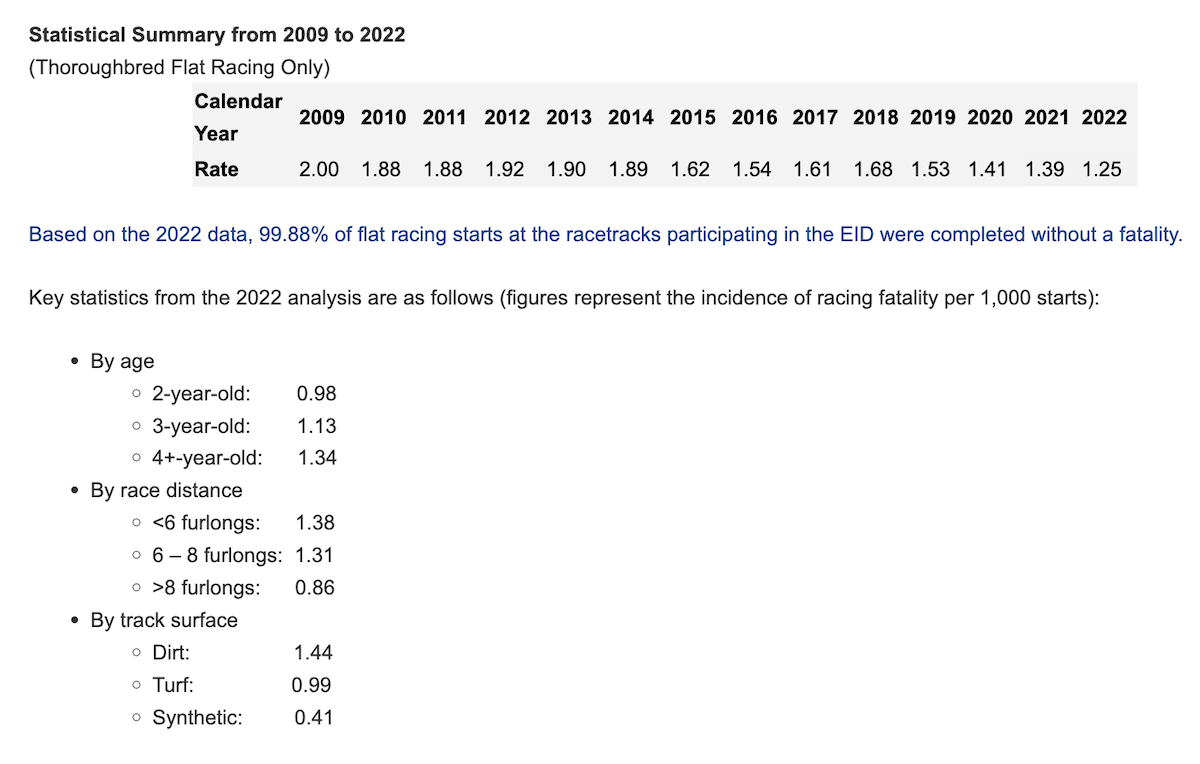
The 2022 figure of 1.25 fatalities per 1,000 starts is record low since tracks began reporting to the EID en masse in 2009.
USA: Initial data analysis from the 14th year of reporting to the Equine Injury Database (EID) shows a decrease in the rate of fatal injury in 2022 (1.25 fatalities per 1,000 starts) compared to 2021 (1.39 fatalities per 1,000 starts).
This is the fourth consecutive year that the rate has decreased, and it is the third consecutive year in which the rate has been below 1.5 fatalities per 1,000 starts. It is the first time ever that the rate has been below 1.3 fatalities per 1,000 starts.
Analysis provided by Professor Tim Parkin (University of Bristol), who has consulted on the EID since its inception, and Dr. Euan Bennet (University of Glasgow), also shows historic low rates of fatality on each surface type, for three-year-old horses, and for race distances longer than eight furlongs.
“The data shows that since 2009, the risk of fatal injury during racing has declined by 37.5%, which is statistically significant,” Parkin said. “The overall downward trends are testament to the benefits of an evidence-based approach to safety, which is only possible thanks to the EID.”

• For trends of the EID since 2009, please click here
Risk of fatal injury on the racecourse decreased by 10.1% from 2021 to 2022, 11.3% from 2020 to 2022, and 18.3% from 2019 to 2022.
“We can say with confidence that the risk of fatal injury is heading in a sustained downward direction both overall and in many specific areas,” Parkin said.
“The six-month period from July 1, 2022, to December 31, 2022, was the safest six-month period on record since the inception of the EID in 2009. This evidence of positive progress is very encouraging and should be applauded by everyone in North American racing.”
Since March 2012, racetracks have been able to voluntarily publish their statistics from the EID on The Jockey Club website. The racetracks that publish their EID statistics reported racing fatalities per 1,000 starts of 0.99 as compared to 1.42 for those that do not publish.
The EID statistics are based on injuries that resulted in fatalities within 72 hours from the date of the race. The statistics are for official Thoroughbred races only and exclude steeplechase races.
Summary statistics for the EID are subject to change due to a number of considerations, including reporting timeliness. All data entered into the EID goes through a multilevel quality control process to ensure the data is completely and accurately reported.
Throughout the course of 2022, approximately 99% of all Thoroughbred starts were included in the EID.
The Equine Injury Database, conceived at the Grayson-Jockey Club Research Foundation’s first Welfare and Safety of the Racehorse Summit, was launched by the (American) Jockey Club in July 2008.
The EID seeks to identify the frequencies, types, and outcomes of racing injuries using a standardized format that generates valid statistics, identifies markers for horses at increased risk of injury, and serves as a data source for research directed at improving safety and preventing injuries.
• For the full list of racetracks reporting to the EID plus detailed statistics, visit the US Jockey Club website
Javier Castellano accepts George Woolf award – pictures from Santa Anita
Elbow room please: what’s it like to shoot an Eclipse Award-winning photo?
View the latest TRC Global Rankings for horses / jockeys / trainers / sires


